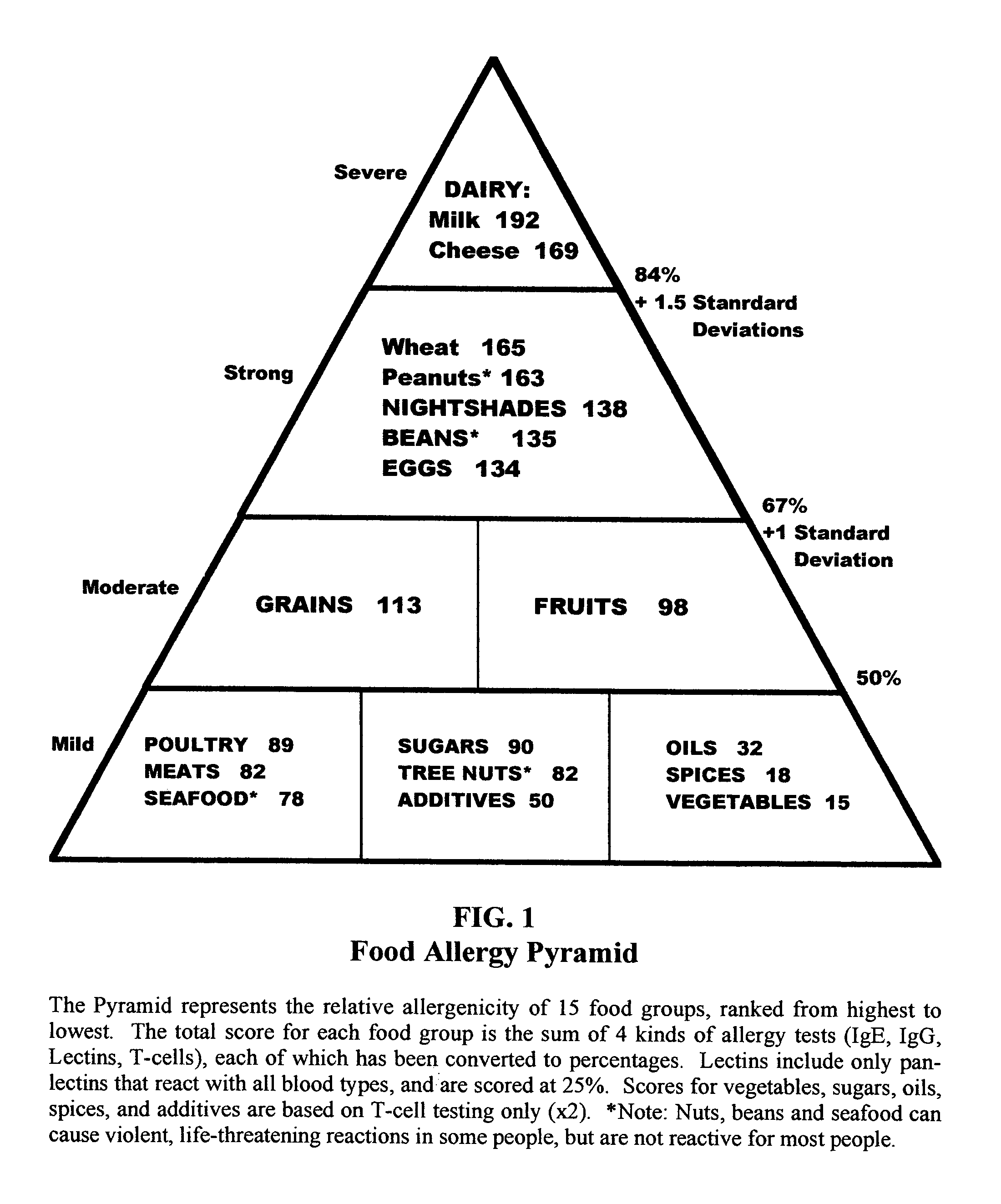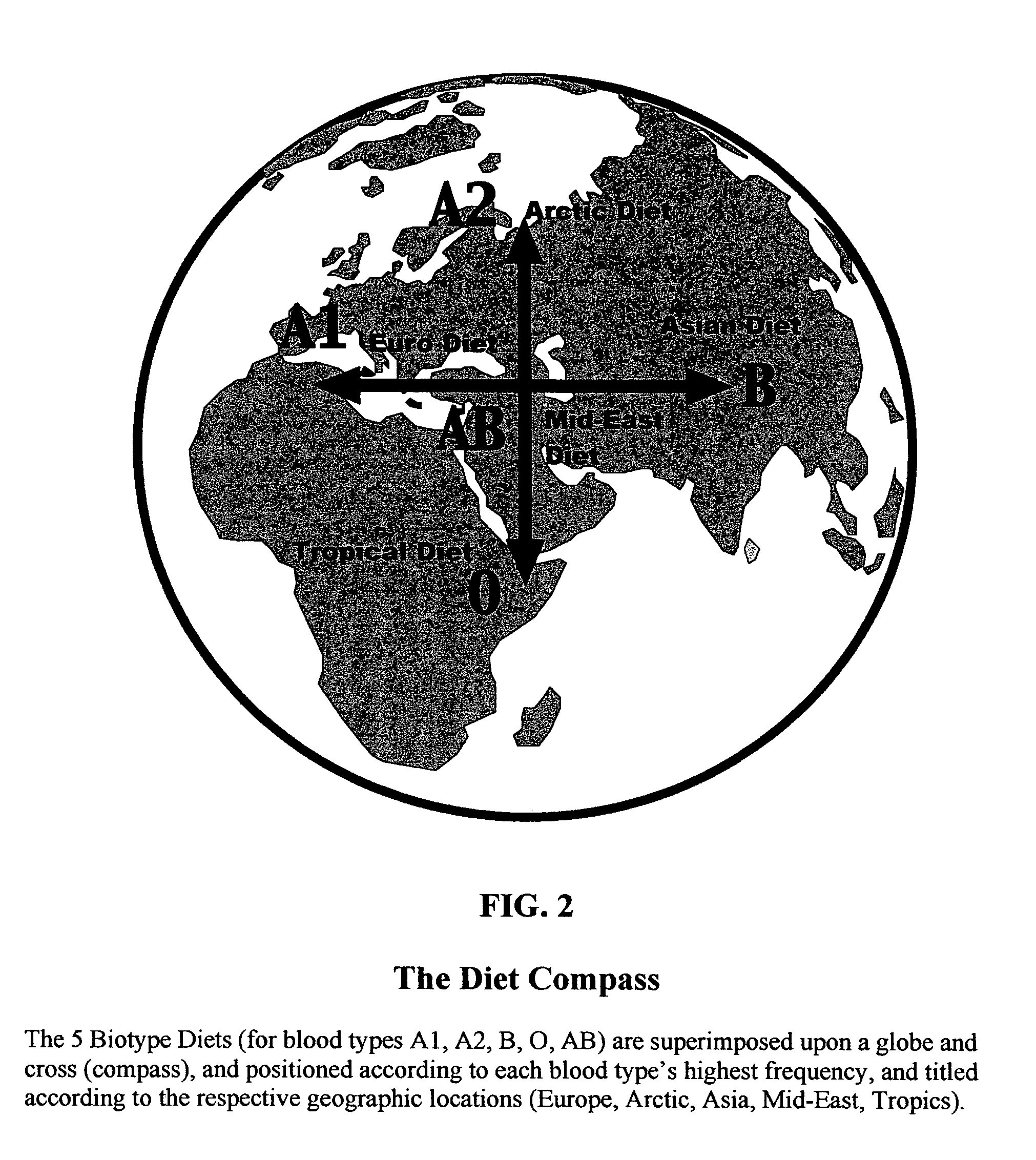Biotype diets system: predicting food allergies by blood type
a biotype diet and food allergy technology, applied in the direction of antibody medical ingredients, chemical indicators, instruments, etc., can solve the problems of inability to predict food allergies by blood type, time-consuming, expensive, dangerous or difficult to obtain, and inability to eat the same foods of all people,
- Summary
- Abstract
- Description
- Claims
- Application Information
AI Technical Summary
Benefits of technology
Problems solved by technology
Method used
Image
Examples
example 1
[0140]The study design was a descriptive study, of the cross-sectional survey and correlational types. This means that it analyzed the prevalence of a disease (several kinds of food allergies), and correlated them statistically to variables that are unaltered over time (blood types).
[0141]The results were arrived at by novel methods. From 1985 to 2000 four studies were conducted for four kinds of food allergies and hypersensitivities, representing the four Gell-Coombs Immune Responses [J. Breneman. Basics of Food Allergy. Thomas, Springfield, Ill., 1984.] Records were obtained from The Nutrition Clinic in Bethesda, Md. and from The Allergy & Nutrition Clinic in Falls Church, Va. Otherwise healthy patients were self-referred for nutrition or food allergy counseling. Of these the first 500 were selected who had not been avoiding suspected food allergens.
[0142]Six blood types were selected as independent variables: A1, A2, B, O, A1B, A2B. Four subtypes were also sel...
example 2a
[0147]Statistical analysis for health and demographic data was compiled in the following manner: Blood types, gender and ethnic background distributions were compared to U.S.A. distributions by chi-square analysis. Age, pulse, blood pressure, and body mass index were compared to U.S.A. population means by student's t-test. Distribution of factors between blood types were analyzed by contingency table analysis. (Data was analyzed by Stateview on Macintosh.) Results showed some statistically-significant deviations from the national norms: more rare blood types (i.e. A2, AB, B, Rh−), more females than males, an older population, normal pulse, lower blood pressure, and higher body mass index.
[0148]
TABLE 2DEMOGRAPHIC DATA FOR 3 STUDIESIgEIgGT-CELLFACTORSSTUDYSTUDYSTUDYTOTALU.S.A.All Subjects175175150500Blood Type A140404412433.6%Blood Type A230301777 8.4%Blood Type B30302080 10%Blood Type O606056176 44%Blood Type AB15151343 4%Blood Type Rh+144144113401 85%Blood Ty...
example 2b
Interpretation of the Data
[0152]Identifying patterns in food allergies relative to blood types or gender was determined by the strength of the reactions (mean test scores) and by statistical significance (p values).
[0153]Establishing classes for the degree of human clinical immune reactivity to foods is problematic in three ways: (1) assigning classes to frequency distributions (ranges) of continuous variables is arbitrary, (2) groups have less extreme ranges than individuals, and (3) the frequency distribution represents a range of healthy to unhealthy food reactions, rather than bivariate normal distribution. Therefore, the preferred method of classification was to apply non-bivariate divisions to the distribution of test scores in each study. Hence the lower ⅓ of food scores was designated as non-reactive (0-33%). The middle ⅓ was designated as equivocal (34% -67%). And the upper ⅓ was designated as reactive (67% -100%). Additional classifications were used at the median (50%), a...
PUM
| Property | Measurement | Unit |
|---|---|---|
| size | aaaaa | aaaaa |
| size | aaaaa | aaaaa |
| Rh | aaaaa | aaaaa |
Abstract
Description
Claims
Application Information
 Login to View More
Login to View More - R&D
- Intellectual Property
- Life Sciences
- Materials
- Tech Scout
- Unparalleled Data Quality
- Higher Quality Content
- 60% Fewer Hallucinations
Browse by: Latest US Patents, China's latest patents, Technical Efficacy Thesaurus, Application Domain, Technology Topic, Popular Technical Reports.
© 2025 PatSnap. All rights reserved.Legal|Privacy policy|Modern Slavery Act Transparency Statement|Sitemap|About US| Contact US: help@patsnap.com



